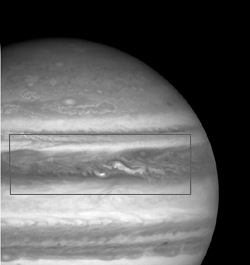
A four-panel frame shows a section of Jupiter's north equatorial belt viewed by NASA's Cassini spacecraft at four different wavelengths, and a separate reference frame shows the location of the belt on the planet.
A fascinating aspect of the images in the four-panel frame is the small bright spot in the center of each. The images come from different layers of the atmosphere, so the spot appears to be a storm penetrating upward through several layers. This may in fact be a "monster' thunderstorm, penetrating all the way into the stratosphere, as do some summer thunderstorms in the midwestern United States. These images were taken on Nov. 27, 2000, at a resolution of 192 kilometers (119 miles) per pixel. They have been contrast-enhanced to highlight features in the atmosphere.
The top panel of the four-panel frame is an image taken in a near-infrared wavelength at which the gases in Jupiter's atmosphere are relatively non-absorbing. Sunlight can penetrate deeply into the atmosphere at this wavelength and be reflected back out, providing a view of an underlying region of the atmosphere, the lower troposphere.
The second panel was taken in the blue portion of wavelengths detected by the human eye. At these wavelengths, gases in the atmosphere scatter a modest amount of sunlight, so the clouds we see tend to be at somewhat higher altitudes than in the top panel.
The third panel shows near-infrared reflected sunlight at a wavelength where the gas methane, an important constituent of Jupiter's atmosphere, absorbs strongly. Dark places are regions without high-level clouds and consequently large amounts of methane accessible to sunlight. Bright regions are locations with high clouds in the upper troposphere shielding the methane below.
The bottom panel was taken in the ultraviolet. At these very short wavelengths, the clear atmosphere scatters sunlight, and hazes in the stratosphere, above the troposphere, absorb sunlight. That makes it difficult to see into lower layers at all. The bright regions are generally free of high stratospheric hazes.
A small bright spot is visible near the center of each panel. Similar spots have been imaged in turbulent regions by the Galileo spacecraft, and they appear to be very energetic convective storms that move heat from the interior of Jupiter to higher altitudes. These storms are expected to penetrate to great heights, and so it is not surprising to see the storm in the first three images, which probe atmospheric altitudes from the lower to the upper troposphere. What is surprising is the appearance of the spot in the ultraviolet image. Higher resolution, time-lapse images to be captured by Cassini in coming weeks will shed more light on these spectacular features.
Cassini is a cooperative project of NASA, the European Space Agency and the Italian Space Agency. The Jet Propulsion Laboratory, a division of the California Institute of Technology in Pasadena, manages the Cassini mission for NASA's Office of Space Science, Washington, D.C.

